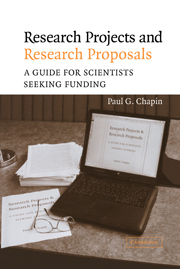Book contents
- Frontmatter
- Contents
- Foreword
- Acknowledgments
- Introduction
- 1 Selecting a Research Topic
- 2 Project Planning
- 3 Identifying Funding Sources
- 4 Special Funding Mechanisms
- 5 Writing a Proposal
- 6 Research Ethics and Responsibilities
- 7 The Natural History of a Proposal
- 8 “We Are Happy/Sorry to Inform You …”
- 9 Managing Your Grant
- Appendix A Glossary of Acronyms
- Appendix B Useful URLs
- Index
9 - Managing Your Grant
Published online by Cambridge University Press: 14 July 2009
- Frontmatter
- Contents
- Foreword
- Acknowledgments
- Introduction
- 1 Selecting a Research Topic
- 2 Project Planning
- 3 Identifying Funding Sources
- 4 Special Funding Mechanisms
- 5 Writing a Proposal
- 6 Research Ethics and Responsibilities
- 7 The Natural History of a Proposal
- 8 “We Are Happy/Sorry to Inform You …”
- 9 Managing Your Grant
- Appendix A Glossary of Acronyms
- Appendix B Useful URLs
- Index
Summary
When your proposal turns into a grant, you turn into an administrator as well as a scientist. Along with conducting your research, you also have to manage the grant. This isn't too onerous a job, but it does require you to pay attention to some matters that you may not have had to worry about before, and to do some things that may be new to your roster of duties. In this chapter, we'll discuss some of the managerial responsibilities that come along with a research grant.
Managing a Research Project
As the PI of a research project funded by a government agency, you are in effect the head of a small business. It's up to you to make sure that you and your staff are working productively, that you have on hand the materials and supplies you need to do the work, that you are using resources wisely and efficiently, that you are staying on schedule and within budget, and that you are reporting as necessary to others who have a stake in your research, including your institution and the funding agency. Fortunately, your institution will take care of some aspects of the management for you, such as meeting your payroll and keeping your accounts; it is in fact precisely because of this that NSF makes grants almost exclusively to institutions rather than to individual scientists, who for the most part haven't the training, the aptitude, the time, or the inclination to take care of such matters.
- Type
- Chapter
- Information
- Research Projects and Research ProposalsA Guide for Scientists Seeking Funding, pp. 135 - 146Publisher: Cambridge University PressPrint publication year: 2004



